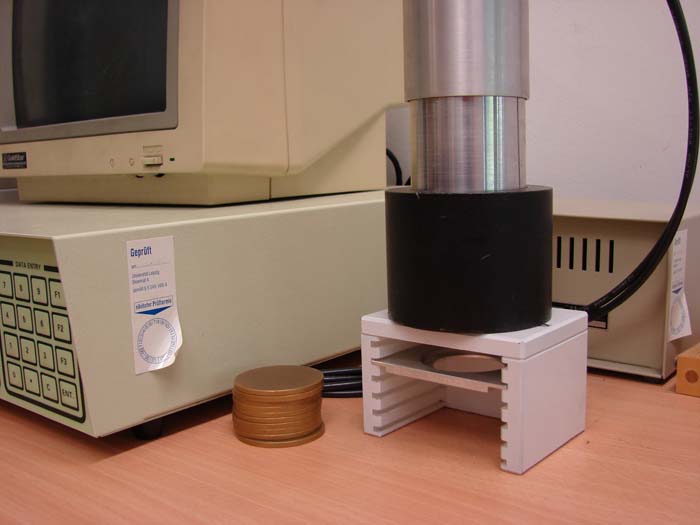ASTM C1415 Gamma Spectrometry for Burnup Determination
The ASTM C1415 standard provides a precise method for determining burnup in spent nuclear fuel by measuring the gamma radiation emitted from fission products. This technique is essential for ensuring compliance with regulatory requirements and optimizing reactor performance.
Burnup, or the amount of fissile material that has undergone fission, is critical to the safe operation and management of nuclear reactors. ASTM C1415 utilizes gamma spectroscopy to quantify this burnup by analyzing the isotopic composition of fission products present in irradiated fuel.
The process involves irradiating nuclear fuel under controlled conditions within a reactor, followed by cooling and chemical processing to separate the fission products from the unreacted fuel. The resulting solution is then analyzed using gamma spectroscopy, which detects and quantifies the emitted gamma rays corresponding to specific isotopes.
Gamma spectrometry works by measuring the energy spectrum of photons emanating from a sample. By comparing these spectra with known standards, technicians can determine the relative abundances of various fission products in the sample. This information is then used to calculate the burnup value based on predetermined calibration factors.
The accuracy and precision of ASTM C1415 are paramount for ensuring reliable results. Various factors such as detector efficiency, background noise, and matrix effects can influence the measurements. Therefore, it is crucial to follow strict procedural guidelines and maintain high-quality laboratory practices.
ASTM C1415 specifies the use of high-purity germanium (HPGe) detectors for gamma spectroscopy due to their excellent energy resolution and sensitivity. These detectors are calibrated regularly against reference standards to ensure consistent performance across multiple analyses.
The method also emphasizes the importance of proper sample preparation, including thorough dissolution procedures and filtration steps to remove particulates that could interfere with the detection process. Additionally, matrix-matched calibration samples are recommended for accurate quantification in complex matrices typical of irradiated fuel solutions.
Once the gamma spectra have been acquired, data processing involves fitting the observed spectrum to a theoretical model using software algorithms designed specifically for this purpose. The resulting fit provides detailed information about the elemental composition and burnup level of the sample.
This method is widely used in both research and industrial settings where accurate determination of burnup is necessary. For example, power plant operators rely on ASTM C1415 to monitor reactor performance over time, ensuring optimal efficiency while minimizing waste generation. In academic institutions, researchers use this technique to study the effects of different fuel cycles and cooling times on nuclear fuel behavior.
The application of ASTM C1415 extends beyond just burnup determination; it plays a vital role in validating other analytical methods employed in spent fuel management. By providing consistent and reproducible results, this standard helps maintain industry-wide standards and promotes international cooperation in nuclear technology development.
Applied Standards
| Standard | Description |
|---|---|
| ASTM C1415-18 | This standard specifies the procedure for determining burnup in spent nuclear fuel using gamma spectroscopy. It covers all aspects from sample preparation to data analysis. |
| ISO 9001:2015 | An international standard that sets requirements for quality management systems, ensuring consistent and reliable test results. |
| IEC 62366-4 | This part of the IEC series provides guidelines on environmental labeling and declaration of energy performance in products related to nuclear technology. |
Scope and Methodology
The scope of ASTM C1415 encompasses the entire process from sample receipt through final analysis and reporting. It includes detailed instructions on how to prepare samples, calibrate equipment, conduct measurements, and interpret data.
The methodology outlined in this standard is based on well-established principles of gamma spectroscopy combined with advanced computational techniques for robust spectral fitting. The procedure ensures that every step contributes accurately to the ultimate goal of determining burnup levels precisely.
Key components include:
- Sample receipt and identification
- Preparation of solutions from irradiated fuel
- Cleaning procedures for eliminating contamination
- Detection setup involving HPGe detectors
- Data acquisition using specialized software
- Data analysis incorporating statistical models
Environmental and Sustainability Contributions
The application of ASTM C1415 not only contributes to the safe handling and disposal of spent nuclear fuel but also supports broader environmental sustainability efforts. By accurately determining burnup, this method helps optimize reactor operations, reducing unnecessary fuel consumption and associated emissions.
Moreover, the precise quantification enabled by gamma spectroscopy allows for better management of radioactive waste streams. This reduces the volume of material requiring disposal, thereby minimizing long-term environmental impacts associated with nuclear energy production.
In addition to operational efficiency gains, ASTM C1415 supports the development of more efficient reactor designs and fuels that can operate at higher burnup levels without compromising safety. Such advancements contribute significantly to reducing lifecycle carbon footprints across the entire nuclear fuel cycle.





